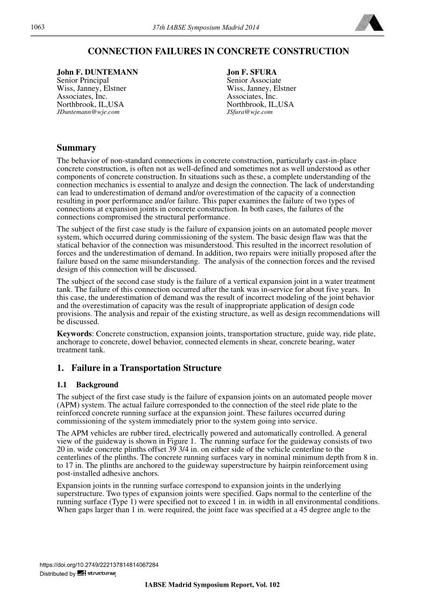Connection Failures in Concrete Construction

|
|
|||||||||||
Bibliographic Details
| Author(s): |
John F. Duntemann
Jon F. Sfura |
||||
|---|---|---|---|---|---|
| Medium: | conference paper | ||||
| Language(s): | English | ||||
| Conference: | IABSE Symposium: Engineering for Progress, Nature and People, Madrid, Spain, 3-5 September 2014 | ||||
| Published in: | IABSE Symposium Madrid 2014 | ||||
|
|||||
| Page(s): | 1063-1070 | ||||
| Total no. of pages: | 8 | ||||
| Year: | 2014 | ||||
| DOI: | 10.2749/222137814814067284 | ||||
| Abstract: |
The behavior of non-standard connections in concrete construction, particularly cast-in-place concrete construction, is often not as well-defined and sometimes not as well understood as other components of concrete construction. In situations such as these, a complete understanding of the connection mechanics is essential to analyze and design the connection. The lack of understanding can lead to underestimation of demand and/or overestimation of the capacity of a connection resulting in poor performance and/or failure. This paper examines the failure of two types of connections at expansion joints in concrete construction. In both cases, the failures of the connections compromised the structural performance. The subject of the first case study is the failure of expansion joints on an automated people mover system, which occurred during commissioning of the system. The basic design flaw was that the statical behavior of the connection was misunderstood. This resulted in the incorrect resolution of forces and the underestimation of demand. In addition, two repairs were initially proposed after the failure based on the same misunderstanding. The analysis of the connection forces and the revised design of this connection will be discussed. The subject of the second case study is the failure of a vertical expansion joint in a water treatment tank. The failure of this connection occurred after the tank was in-service for about five years. In this case, the underestimation of demand was the result of incorrect modeling of the joint behavior and the overestimation of capacity was the result of inappropriate application of design code provisions. The analysis and repair of the existing structure, as well as design recommendations will be discussed. |
||||
| Keywords: |
concrete construction expansion joints Anchorage to concrete transportation structure guide way ride plate dowel behavior connected elements in shear concrete bearing water treatment tank
|
||||
